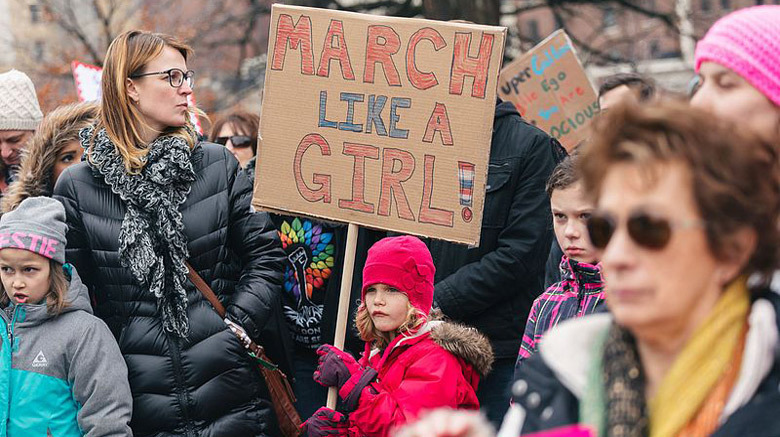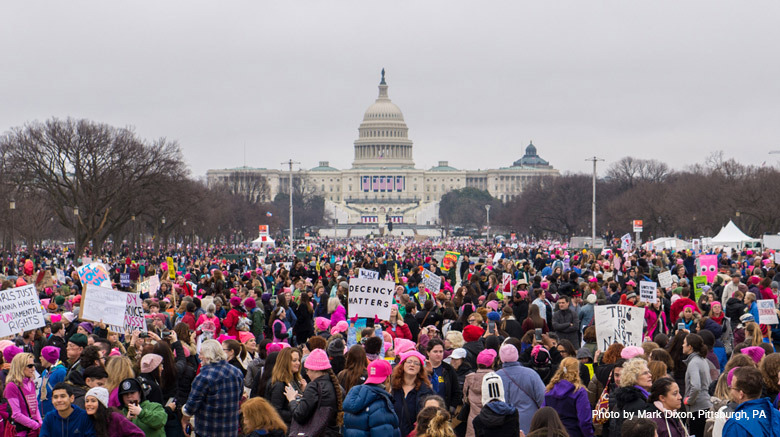Carolyn Gallogly spent last Saturday “bunched up” on either a crammed bus or a crowded street, but the SJC Long Island human services professor wouldn’t have had it any other away.
The empowerment, solidarity and support that came with making American history and participating in the Jan. 21 Women’s March on Washington quashed her discomfort.
“I never heard complaints Saturday,” said Gallogly, Ph.D., one of a handful of SJC professors and staffers who participated in the Women’s March on Washington and a sister march in New York City. “I only heard people saying positive things, giving positive smiles and reinforcing positive messages.”
More than 4.8 million men and women took part in the worldwide protest – in Washington, D.C. and in at least 672 other locations – in support of women’s rights, LGBTQ rights, racial injustice, environmental protection among other causes. The rallies were aimed at Donald Trump, the day after his inauguration as President of the United States.
“The ultimate message of the march as a global day of action is that we can create a world of dignity and respect for all,” said S. Susan Wilcox, C.S.J., director of SJC Brooklyn’s Campus Ministry. “We can create harmony and balance with the planet and its life cycles. To do that, we will have to take responsibility and take action.”
S. Wilcox traveled to Washington, riding on a bus that picked her up at the motherhouse of the Sisters of St. Joseph in Brentwood, N.Y. She noted that throughout the trip south, “the spirit was high and so was the feminine energy of cooperation.”
Gallogly viewed participating in the women’s march as an opportunity for her to advocate for women’s rights — locally and globally.
Antoinette Hertel, Ph.D., chairwoman of SJC Long Island’s Department of Modern Languages, was among the hundreds of thousands of marchers in Midtown Manhattan on Saturday. She believes the women’s marches were only “the beginning.”
“Going forward, we will have to be more active, participatory and social justice-oriented citizens if we want to be successful in protecting our rights,” she said.
Hertel enjoyed seeing people of all ages, genders, races and religions marching and chanting in unity. Gallogly also spoke of the diversity of marchers, as well as the personal interactions she experienced with fellow protestors — ranging from receiving positive support from the metro employees to exchanging a thumbs up with a child who shyly hid behind her poster. In particular, she remembered hugging a young woman wearing a coat that read, “My country wants to send me back.”

A young girl holds a sign during the rally for the Women’s March Jan. 21, in Madison, WI. (Photo by Amandalynn Jones)
Images of thousands of homemade signs — raised high over heads, propped up on sticks, worn on bodies and everything in-between during the women’s marches — have been plastered across social media and featured in news reports worldwide.
The messages Hertel saw in the signs marchers carried in New York City represented a clear indication of a massive resistance to the erosion of women’s intersectional rights. Along with delivering powerful messaging, Gallogly said the signs provided a lot of entertainment while she and other protesters in Washington stood in clusters, unable to move.
“From the beginning, this march had a very broad purpose and appealed to a wide spectrum of political beliefs,” Gallogly said. “But the underlying basis for all of it was women.”
S. Wilcox added, “We will have to take responsibility and take action. And by doing this, we will build a community of trust by building relationships with each other and all of life.”

